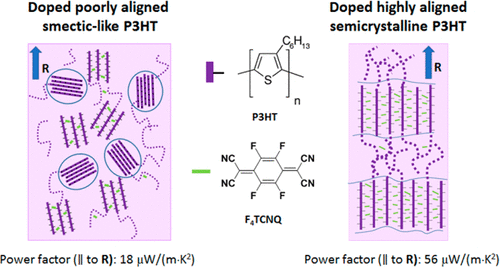当前位置:
X-MOL 学术
›
Macromolecules
›
论文详情
Our official English website, www.x-mol.net, welcomes your feedback! (Note: you will need to create a separate account there.)
Control of Chain Alignment and Crystallization Helps Enhance Charge Conductivities and Thermoelectric Power Factors in Sequentially Doped P3HT:F4TCNQ Films
Macromolecules ( IF 5.5 ) Pub Date : 2020-03-20 , DOI: 10.1021/acs.macromol.9b02389 Viktoriia Untilova 1 , Till Biskup 2 , Laure Biniek 1 , Vishnu Vijayakumar 1 , Martin Brinkmann 1
Macromolecules ( IF 5.5 ) Pub Date : 2020-03-20 , DOI: 10.1021/acs.macromol.9b02389 Viktoriia Untilova 1 , Till Biskup 2 , Laure Biniek 1 , Vishnu Vijayakumar 1 , Martin Brinkmann 1
Affiliation

|
Thermoelectricity has gained considerable interest in the past decade due to the advent of organic thermoelectric materials. Crystallinity and doping level crucially determine the thermoelectric figure of merit of semiconducting polymers. Hence, detailed insight into these factors is prerequisite for developing efficient devices. Here we show that the semicrystalline structure of aligned P3HT films shows superior thermoelectric efficiencies as compared to the smectic-like phase because of both a higher in-plane orientation and a higher doping level. Conductivities up to 160 S/cm and power factors of 56 μW m–1 K–2 along the rubbing direction are obtained versus a few μW m–1 K–2 for nonoriented films. Different intercalation mechanisms of F4TCNQ in the layers of alkyl side chains are evidenced by electron diffraction in doped oriented films of the smectic-like and the semicrystalline phases. We provide compelling evidence that doping of the smectic-like phase promotes ordering of P3HT backbones along the chain direction within individual π-stacks, whereas for the semicrystalline phase dopant intercalation reorganizes the arrangement of successive π-stacks and perturbs the packing of alkyl side chains. Insight into the orientation of F4TCNQ– anions in the layers of alkyl side chains of P3HT crystals was further retrieved from a detailed polarized UV–vis–NIR spectroscopic analysis. Our results demonstrate that both orientation of the polymer chains and crystallinity enhance the thermoelectric properties as well as the doping level. We anticipate that detailed control of polymer morphology in films further improves the thermoelectric figure of merit of semiconducting polymers.
中文翻译:

控制链排列和结晶有助于增强顺序掺杂的P3HT:F 4 TCNQ薄膜的电荷电导率和热电功率因数
在过去的十年中,由于有机热电材料的出现,热电引起了极大的兴趣。结晶度和掺杂水平决定了半导体聚合物的热电性能。因此,对这些因素的详细了解是开发高效设备的前提。在这里,我们表明,与取向层状相相比,取向的P3HT膜的半晶体结构显示出更高的热电效率,因为它具有更高的面内取向和更高的掺杂水平。沿着摩擦方向获得的电导率高达160 S / cm,功率因数为56μWm –1 K –2,而摩擦力为几μWm –1 K –2用于非定向电影。F 4 TCNQ在烷基侧链层中的不同嵌入机制由近晶状和半晶相的掺杂取向膜中的电子衍射证明。我们提供了令人信服的证据,证明近晶状相的掺杂可促进P3HT主链沿单个π堆栈内的链方向排列,而对于半晶相,掺杂剂插层可重组连续的π堆栈的排列并扰乱烷基侧链的堆积。了解F 4 TCNQ的方向–P3HT晶体的烷基侧链层中的阴离子进一步从详细的偏振UV-vis-NIR光谱分析中获得。我们的结果表明,聚合物链的取向和结晶度均增强了热电性能以及掺杂水平。我们预期对薄膜中聚合物形态的详细控制将进一步改善半导体聚合物的热电性能。
更新日期:2020-04-24
中文翻译:

控制链排列和结晶有助于增强顺序掺杂的P3HT:F 4 TCNQ薄膜的电荷电导率和热电功率因数
在过去的十年中,由于有机热电材料的出现,热电引起了极大的兴趣。结晶度和掺杂水平决定了半导体聚合物的热电性能。因此,对这些因素的详细了解是开发高效设备的前提。在这里,我们表明,与取向层状相相比,取向的P3HT膜的半晶体结构显示出更高的热电效率,因为它具有更高的面内取向和更高的掺杂水平。沿着摩擦方向获得的电导率高达160 S / cm,功率因数为56μWm –1 K –2,而摩擦力为几μWm –1 K –2用于非定向电影。F 4 TCNQ在烷基侧链层中的不同嵌入机制由近晶状和半晶相的掺杂取向膜中的电子衍射证明。我们提供了令人信服的证据,证明近晶状相的掺杂可促进P3HT主链沿单个π堆栈内的链方向排列,而对于半晶相,掺杂剂插层可重组连续的π堆栈的排列并扰乱烷基侧链的堆积。了解F 4 TCNQ的方向–P3HT晶体的烷基侧链层中的阴离子进一步从详细的偏振UV-vis-NIR光谱分析中获得。我们的结果表明,聚合物链的取向和结晶度均增强了热电性能以及掺杂水平。我们预期对薄膜中聚合物形态的详细控制将进一步改善半导体聚合物的热电性能。



























 京公网安备 11010802027423号
京公网安备 11010802027423号